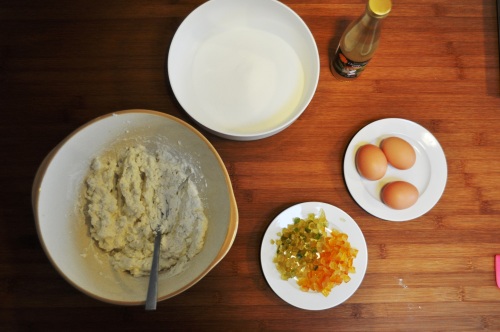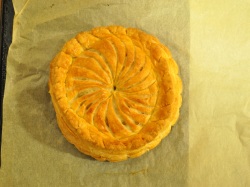
The past week or so I’ve been playing around with puff pastry. The first recipe I made was from Ginette Mathiot’s The Art of French Baking. I used this for my galette des rois Epiphany tart, but wasn’t entirely satisfied with it, so I started reading up and decided to compare some different recipes.
I’ve made puff pastry in the past, but like most home cooks I’ll either do rough puff or just buy ready-made. It always just seemed a bit of a faff to do at home, especially after I’d done it at college on a pastry break, aka dough sheeter, aka laminating table – a kind of conveyor belt with adjustable rollers that makes it so much easier and quicker to make laminated dough or pastry.
That’s what puff pastry is – it’s laminated, it consists of layers, lots of layers. Although croissants or cornetti are also laminated, they use a yeasted dough. Puff pastry doesn’t contain any leaven or raising agent, and lift mostly relies on the lamination, with layers of butter trapped between layers of a simple dough. When it’s baked, the water in the mixture turns to steam, tries to expand and pushes upwards. The fat layers trap it, opening up the product.
In French, classic puff pastry is called pâte feuilletée*. The whole art of making it and using it is called feuilletage, which can also be translated as lamination. The basic technique involves creating a simple paste that’s predomiantly flour and water, called the détrempe, and laminating into it butter (or other fat), called the beurrage.
Puff pastry/Pâte feuilletée from The Art of French Baking by Ginette Mathiot
This book was originally published in 1932. If you look at older recipe books, there’s often quite a lot assumed on the part of the writer and the recipe can seem cursory to modern readers. Such is the case here, when you compare it to books – or indeed blogs – with lots of helpful pics.
200g plain flour
Pinch of salt
100g ice cold water
100g butter, diced and softened

1. Sieve the flour and salt into a bowl and add most of the water to create “a smooth, elastic dough adding the rest of the water if necessary.”

2. On a lightly floured work surface, roll it out. She says 15mm thick, which seems a bit thick considering the quantities. She doesn’t give any guidelines for how big a sheet of pastry you’re aiming for.

3. Add the butter to middle of the sheet “and fold over the flour corners” to enclose.

4. Wrap and chill for 10 minutes in the fridge.
5. Roll out again, this time to a “long rectangle 5mm thick”.



6. “Fold the short ends to overlap in the centre, like a business letter, to make a smaller rectangle with 3 layers.”
7. Chill 15 minutes.
8. Roll out again and repeat.
9. Chill 15 minutes and “Do this six more times”, this is called six more turns.
10. “After the sixth turn the pastry is ready but the more turns you do, the more layers the pastry will have.”
This is the most basic recipe in terms of a straight détrempe and beurrage. I found it didn’t puff up that well but that may have been partly to do with my learning curve, as you can see from the pics this wasn’t the most refined batch. I did it again, more neatly but it still didn’t puff up that well, though it made for some delicious sausage rolls.

All-butter English puff pastry from Short & Sweet by Dan Lepard
Short & Sweet collects Dan Lepard’s essential recipes from his run in The Guardian. You can find a version of this recipe here, though I highly recommend the book, which includes a tweaked version containing egg.
Dan L writes “this recipe is based on an old English method from the late 1800s that varies from the French puff pastry recipes from that era, in that it adds more of the butter when mixing to the dough.” He says this makes it easier to roll, and “very delicate and tender” once baked. What interested me here was a Britain-based Australian baker doing an old English recipe from probably only a few decades before the French Mathiot recipe.
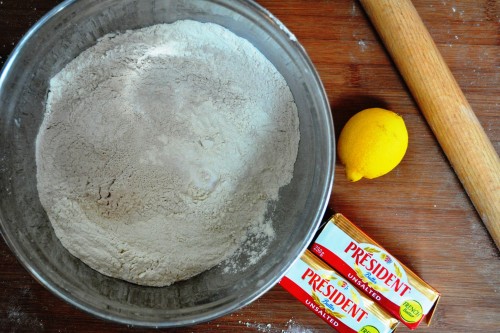
275g plain flour
275g strong white flour
1 tsp fine salt
550g butter, “cold but pliable”
2 tsp lemon juice
1 egg yolk
175g cold water


1. Sieve the flour and salt into a bowl and add 125g of the butter, cut into small pieces and rub in fully.
2. Beat together the water, lemon juice and egg yolk then add this to the flour and “knead to form a consistent dough.”
3. Wrap and chill for 30 minutes.
4. Roll out to about 50x30cm.
5. Slice the butter and lay this over two-thirds of the dough. Fold down the unbuttered third, then fold up the buttered third at the opposite end. So you are doing a single book fold again, just adding the butter in a different fashion.
6. Roll the top slightly to press out any air bubbles.
7. “Seal the edges with a sharp thwack of the pin” then wrap and chill for 30 minutes.
8. Roll out again to 60x20cm and fold the thirds again, so the parcel is about 20x20cm
9. Cover and chill again.
10. Roll out again, repeat. Chill, repeat – giving four more “turns”, resting between each.
As with so many Dan Lepard recipes, this one just works. There’s enough detail to explain, but not so much you get boggled. I used some to make a pie (main pic, above) and it puffed wonderfully.
Feuilletage Jean Millet from The Roux Brothers on Patisserie
The essential text The Roux Brothers on Patisserie was published in 1986, reprinted in 1991 and given to me as a Christmas present by my parents in 1995. I’ve enjoyed a lot of challenges from it over the years, and plenty of delicious results. I’d not tried their puff before though. They credit it to “our friend Jean Millet, the president of the Confédération de la Pâtisserie, Confiserie, Glacerie de France and MOF in patisserie,” which isn’t intimidating at all.
500g flour
200g water
12g / 1.5 tsp salt
25g white wine vinegar
50g butter, melted
400g butter, well chilled

1. They combine the liquid into the flour working it on a work surface. I just used a bowl – flour, salt, then add the water, vinegar and the butter (which I allowed to cool a bit after melting). “When all the ingredients are well mixed, work the dough with the palm of your hand until it is completely homogenous, but not too firm.”

2. Form a ball and cut a cross in the top.
3. Wrap and chill for 2-3 hours.

4. On a lightly floured surface, roll out – extending the quarters formed by the cut to create four ears, with a small mound in the middle.

5. Put the chilled butter between two sheets of parchment or plastic and hit with the pin, “so that it is supple but still firm and very cold.”

6. Place the flattened butter in the middle of the dough then fold over the ears to enclose it.
7. Wrap and chill for 30 minutes “to bring the butter and dough to the same temperature.”

8. Roll out to about 70x40cm. “Fold over the ends to make 3 layers. This is the first turn.” Ie, you’re doing another single book fold.
9. Roll out and fold again. “This is the second turn.”
10. Wrap and chill 30 minutes.
12. “Make 2 more turns” then rest for 30 minutes to hour in the fridge.
13. “Make 2 more turns bring the total to 6.”
This worked well too. As with Dan L’s, you incorporate some of the fat into the détrempe, making it easier to handle. As with Dan L’s it also makes quite a lot – about 1.2kg. So you can cut it into portions and freeze them.

This is the batch I used to make my pithivier. I’ll include this pic again, as it show very clearly some great puffing action.

Observations and tips
Flour – Mathiot stipulates plain flour (equivalent to all-purpose in the US), while Dan L uses a mixture of plain and strong, and the Roux brothers don’t specify. My old teacher said to use all strong flour. Stron (higher protein) flour is more resilient to all the manhandling and manipulation involved and will also give more lift in the oven. Plain (lower protein) flour will give a shorter texture, so will aid the melt-in-the-mouth quality. Always one to try and find an amenable middle ground, I’d recommend Dan L’s half-half approach.
Fat – proper puff pastry needs butter. This can be problematic for people on certain diets, but personally I don’t want to eat “pastry fat” – which is made from hydrogenated vegetable oils. The body simply cannot metabolise hydrogenated fats. Plus, butter simply tastes better, and doesn’t leave the iffy dry mouth-feel of some more processed fats.
Always make sure the fat you’re using is at a similar temperate to the paste, the détrempe. This means cold but pliable. As for the type of butter, Dan L says “You get the lightest pastry using a butter with a low moisture content, like Lurpak or Président” (ie Danish or French) but as I prefer to use local produce, I wanted to at least use English butter; Yeo Valley organic seemed to work well too. Oh, and generally unsalted makes most sense, as it’s more versatile for sweet or savoury products.
Combining – cutting the cross and making the ears is known as the French method. Slicing up the butter and laying it on two thirds of the rectangle is known as the English method. I found it easiest to handle the butter, and start the folding, when it was beaten with the rolling pin, as opposed to cubed or sliced, which seemed more likely to cause breaches. So when I tried Dan L’s I smeared the slices a bit to take off any sharp edges.
Acid – as these three recipes have shown, some call for lemon juice, others vinegar, while Mathiot’s contains neither. My online travels showed me that Richard Bertinet, Anna Olsen and Joe Pastry, among others, include lemon juice. Paul Hollywood doesn’t include any acid. The only explanation of the acid I can find is that helps prevent the pastry from oxidising and turning grey and helps tenderize it. In my case, I tend to use stoneground flours, rather than shiny bleached flours, so my doughs are always off-white anyway. Once baked, I don’t think it makes much difference with pastry, especially if you glaze it.
Resting and temperature – you have to rest the dough when you handle it a lot. This is for two reasons. Firstly, you don’t want to melt the butter or it’ll just blend with the paste, destroying the layers, so it’s always best to keep it below about 16C. Secondly, if you overwork the paste or dough, it’ll toughen up; resting it allows the gluten to relax and stay pliable. Resting times really seem to vary in these recipes, but I found Mathiot’s too short and more than 30 minutes potentially tricky, as if you fridge is at 4C, it’ll get too cold, reducing that pliability again, meaning you’ll probably need to let it warm up again before pinning it out. If it’s too cold, the butter can break through the layers of paste. That said, you may need to leave it in the fridge longer to fit in with your other commitments!
Folds and turns – when you roll it out and fold it up, that’s a turn. There are different techniques. I just stuck with the technique of folding the rectangle in thirds. You can also quarter the rectangle, folding both ends in towards the centre, then folding again in the centre, as if it’s the spine of a book. This immediately creates more layers. There seems to be some confusion over the names of these techqniques. Some call the former a half-turn or single book turn, while others called the latter a book turn or a double book turn. I’m not going to try and authoritatively name either.
Pinning out – when you pin it out, make sure you have the open ends of the parcel in the direction you’re rolling. Try to keep your piece of pastry in a rectangular shape, with straight-ish edges and square-ish corners. This takes a little practice, you can straighten up the edges with your rolling pin and stretch or pin out the corners. Also, when you fold it, take care with any air bubbles. You can press these out, or even jab then with the point of a knife, though this isn’t ideal. You’re trying to build up consistent layers.
Using it – it keeps well in the freezer, or for up to about 3 days in the fridge. When you’re using it for pastries, or pies, or tarts, it always benefits from being washed with whole egg or yolk, but when you do try to avoid any edges or it’ll seal them up and stop it rising and puffing nicely. Before baking, let it rest again, for more than 20 minutes and even overnight, as this will prevent it from distorting when it’s put in the oven. Dan L even freezes his again before using, once it’s pinned out. Bake it at a hot temperature, 200C plus.
Conclusion
Unless you’re some kind of pastry purist, I’d recommend a recipe that incorporates a bit of the total fat into the détrempe. I’ve even seen recipes that incorporate a bit of the flour into the beurrage but I’m not sure that’s really necessary. I’d also recommend the recipes with a higher fat: flour ratio. The Mathiot recipe seems a bit meagre and modest with, in baker’s percentages 100% flour to 50% fat, when the Dan L is 100% fat and the Roux-Millet is 90% fat. Technically the Mathiot can be called a “half-puff” while Dan L’s is “full-puff”. As many chefs will tell you, fat is flavour, and good butter is delicious, never mind how it helps give that wonderful flaky, delicate, melty texture to the pastry.
I realise this is probably the longest post on this blog, but I hope a few get to the end and find it useful. I haven’t got into any maths [l = (f + 1)n] or mentioned the “Dutch or Scottish method”, but maybe I’ll talk about that in another post on rough puffs at some stage.

* The French word pâte is related to the English words paste and pastry and the Italian words pasta, impasto, pastella etc, and they all come from the Greek for stewed barley, via the Latin. Feuille means leaf or sheet, and like the English folio or Italian foglia and foglio comes from the Latin.



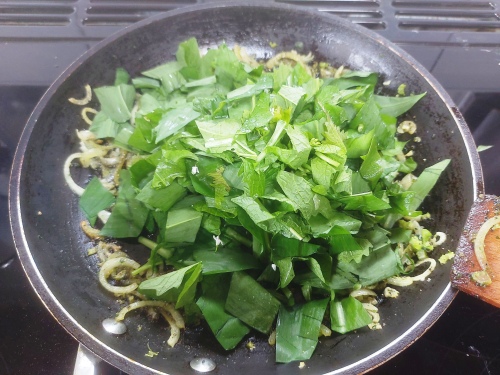























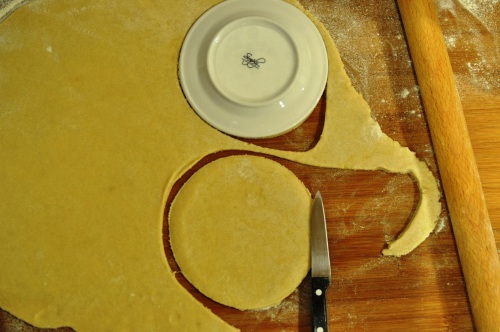

 v
v 























